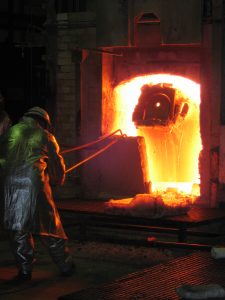by Jill Turnbull, author of From Goblets to Gaslights.
**
When David Caldwell introduced me as an ‘amateur’ at the launch of my new book, it aroused some ire in the audience, as they told me afterwards. What they did not know is that he had asked me about it first. I had never defined myself in that way, nor given it much thought, but since I have never trained as an historian, my remit is a narrow one, and I do what I do for the love of it – yes, I’m an amateur. Some perceived it as derogatory, and if I thought David had meant that I was amateurish, so would I, but he made it clear he did not. Thinking about it since has reinforced my awareness of how fortunate I am to be able to call myself an amateur historian, using the OED definitions: ‘One who loves, is fond of, or has a taste for, anything’ and ‘One who cultivates anything as a pastime’.

Removing the second siege block to reveal a very damaged pot which had been in the furnace for the unusually long time of 20 weeks. Edinburgh Crystal 2004 © Jill Turnbull
As a pastime, researching the history of the Scottish glass industry has been the source of knowledge, excitement and entertainment as well as contact with interesting people and places of a richness I could never have dreamed of when choosing the subject of my PhD thesis in 2005. When my supervisor-to-be, Professor Michael Lynch, said I would need palaeography, I had no idea what he meant. Discovering, and learning to read, 17th-century Scottish handwriting was a revelation, challenging and fascinating.
As an amateur retiree I am fortunate that I do not have to worry about my career, I can work when, where and on what subject I choose: the only pressures are self-inflicted. Research in the rich archives of Scotland, ranging from legal documents in the National Records of Scotland, family papers saved by descendants, the invoices of Dukes and Earls carefully bundled up and preserved by factors, scandals exposed in newspapers, government reports, and much more, is a fascinating pastime. A mixture of detective work, treasure hunt, and slogging through pages that yield nothing, frustrating days when you wonder why you bother, then that frisson of excitement when you find what you are looking for – or, even better, a piece of information you were not expecting.
Perhaps one of the main advantages of not being a professional historian is the lack of boundaries. I have not been schooled in economic, social or political history, nor archaeology, so there are no constraints. Clearly industry is affected by everything: the 1745 political decision to impose an excise duty on glass produced in Britain, and its increasing severity over the following century, had a huge impact. But so did cholera outbreaks, changes in fashion, the Napoleonic War destroying the claret trade with France (hitting the bottle industry in Leith) and improvements in glass from Europe. The rise of the unions, family squabbles, the invention of gas and electric lighting, and personal and business rivalries all had an impact.
Researching my first book, which covers 1610-1750, made me aware of major scandals involving aristocrats and MPs, and even a murder. In 1688 glassworks owner Sir James Standsfield was killed by his son Philip, whose trial was the last in Scotland to cite bahr-recht. He was hung, his tongue was cut out and burned and his right hand was displayed in Haddington. You never know where research will lead you!
As a retired English social worker, moving to Edinburgh when my Scottish husband retired in 1989, I had never heard of sasines or Registers of Deeds. Now I know much more about Scottish legal terms than I do English, I have explored more of Scotland than most of my Scottish friends – I like to visit the places I research – and I have met and talked to people working in the glass industry, gaining invaluable insights into their methods. Having been privileged to spend time at Edinburgh Crystal before they stopped making their own glass in 2004, I was able to assist with the National Museum of Scotland’s oral history project, to record members of the workforce for posterity. The glass industry has gone, the skilled workers redundant. It is all too easy to lose the history of a business when it closes and I have heard people blaming museums and other institutions for not rescuing archives and other material. The truth is they have neither the time nor the staff – it is often the focussed and devoted amateurs who often do sterling work in raising the alarm, saving and recording our heritage.
And for myself, as an amateur (who hates getting it wrong) if I make daft mistakes it’s my own fault and no-one else will suffer (not so in my previous career) and as long as my eyes, brain and curiosity hold out there will always be more projects to work on. It’s a rewarding and enjoyable pastime.
Having spent the last twenty years on a voyage of discovery about the products, places, problems, successes and failures in the Scottish glass industry, the ultimate pleasure is to see the end result published by the Society.
Now for something new.
**
Jill Turnbull’s new book, From Goblets to Gaslights: The Scottish Glass Industry 1750-2006 was published in June 2017 and is available to buy from our online shop now. Jill’s previous book, The Scottish Glass Industry 1610-1750 is available to read online at the Archaeology Data Service.
Help us: champion research; stimulate discussion; enhance public understanding; and share our extraordinary heritage. Donate directly to the Society now.